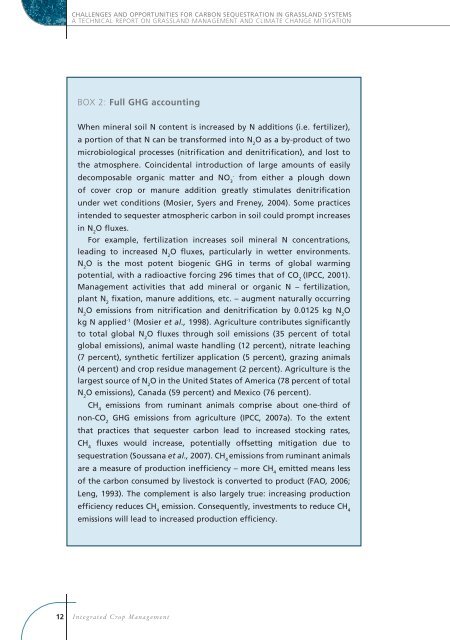Challenges and opportunities for carbon sequestration in ... - FAO
Challenges and opportunities for carbon sequestration in ... - FAO
Challenges and opportunities for carbon sequestration in ... - FAO
Create successful ePaper yourself
Turn your PDF publications into a flip-book with our unique Google optimized e-Paper software.
<strong>Challenges</strong> <strong>and</strong> <strong>opportunities</strong> <strong>for</strong> <strong>carbon</strong> <strong>sequestration</strong> <strong>in</strong> grassl<strong>and</strong> systemsA Technical Report on Grassl<strong>and</strong> Management <strong>and</strong> Climate Change MitigationBox 2: Full GHG account<strong>in</strong>gWhen m<strong>in</strong>eral soil N content is <strong>in</strong>creased by N additions (i.e. fertilizer),a portion of that N can be trans<strong>for</strong>med <strong>in</strong>to N 2O as a by-product of twomicrobiological processes (nitrification <strong>and</strong> denitrification), <strong>and</strong> lost tothe atmosphere. Co<strong>in</strong>cidental <strong>in</strong>troduction of large amounts of easily-decomposable organic matter <strong>and</strong> NO 3from either a plough downof cover crop or manure addition greatly stimulates denitrificationunder wet conditions (Mosier, Syers <strong>and</strong> Freney, 2004). Some practices<strong>in</strong>tended to sequester atmospheric <strong>carbon</strong> <strong>in</strong> soil could prompt <strong>in</strong>creases<strong>in</strong> N 2O fluxes.For example, fertilization <strong>in</strong>creases soil m<strong>in</strong>eral N concentrations,lead<strong>in</strong>g to <strong>in</strong>creased N 2O fluxes, particularly <strong>in</strong> wetter environments.N 2O is the most potent biogenic GHG <strong>in</strong> terms of global warm<strong>in</strong>gpotential, with a radioactive <strong>for</strong>c<strong>in</strong>g 296 times that of CO 2(IPCC, 2001).Management activities that add m<strong>in</strong>eral or organic N – fertilization,plant N 2fixation, manure additions, etc. – augment naturally occurr<strong>in</strong>gN 2O emissions from nitrification <strong>and</strong> denitrification by 0.0125 kg N 2Okg N applied -1 (Mosier et al., 1998). Agriculture contributes significantlyto total global N 2O fluxes through soil emissions (35 percent of totalglobal emissions), animal waste h<strong>and</strong>l<strong>in</strong>g (12 percent), nitrate leach<strong>in</strong>g(7 percent), synthetic fertilizer application (5 percent), graz<strong>in</strong>g animals(4 percent) <strong>and</strong> crop residue management (2 percent). Agriculture is thelargest source of N 2O <strong>in</strong> the United States of America (78 percent of totalN 2O emissions), Canada (59 percent) <strong>and</strong> Mexico (76 percent).CH 4emissions from rum<strong>in</strong>ant animals comprise about one-third ofnon-CO 2GHG emissions from agriculture (IPCC, 2007a). To the extentthat practices that sequester <strong>carbon</strong> lead to <strong>in</strong>creased stock<strong>in</strong>g rates,CH 4fluxes would <strong>in</strong>crease, potentially offsett<strong>in</strong>g mitigation due to<strong>sequestration</strong> (Soussana et al., 2007). CH 4emissions from rum<strong>in</strong>ant animalsare a measure of production <strong>in</strong>efficiency – more CH 4emitted means lessof the <strong>carbon</strong> consumed by livestock is converted to product (<strong>FAO</strong>, 2006;Leng, 1993). The complement is also largely true: <strong>in</strong>creas<strong>in</strong>g productionefficiency reduces CH 4emission. Consequently, <strong>in</strong>vestments to reduce CH 4emissions will lead to <strong>in</strong>creased production efficiency.12Integrated Crop Management

















